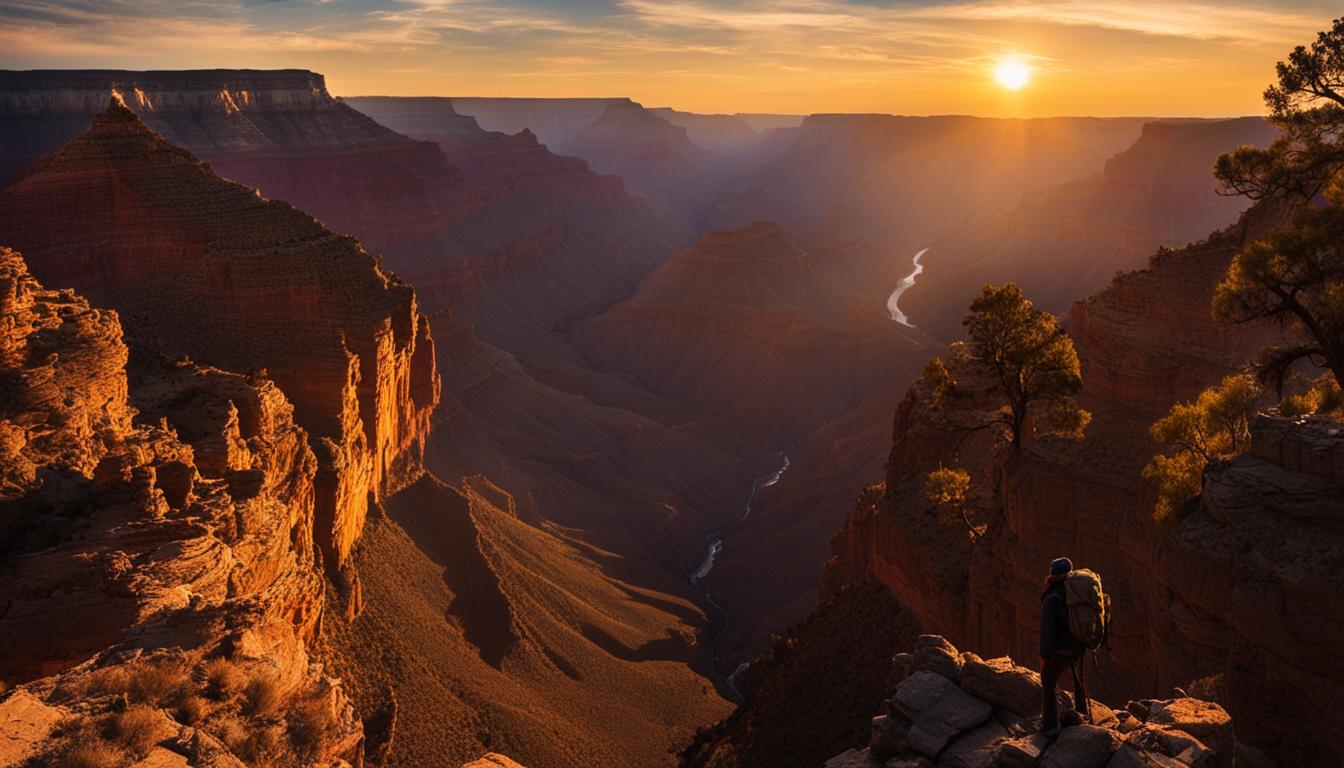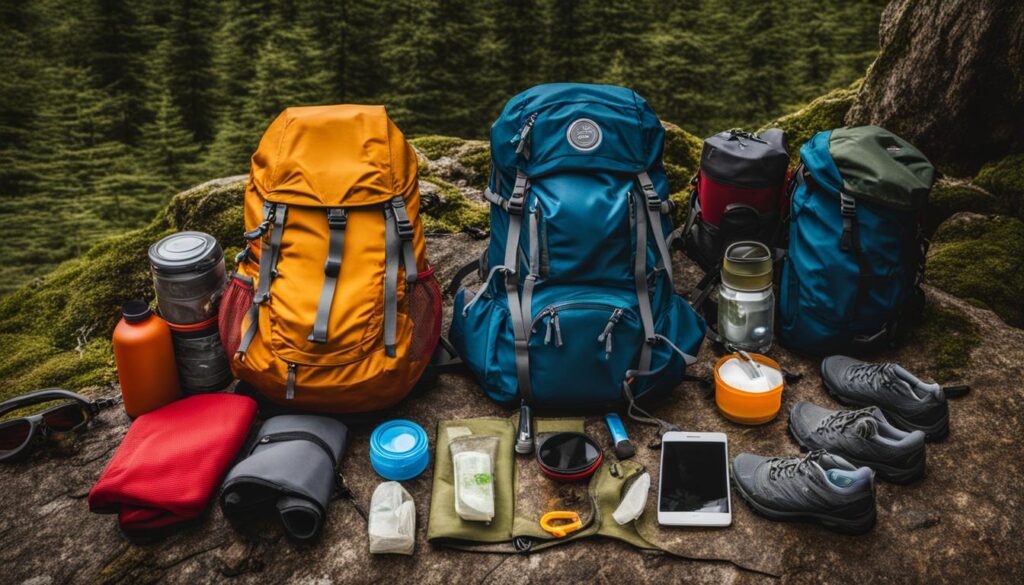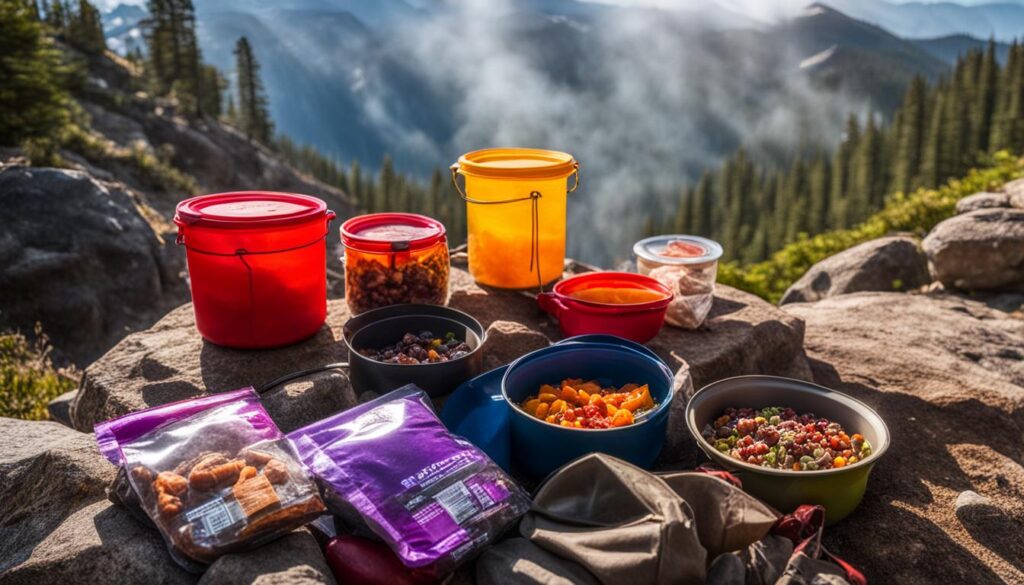Unleash Adventure with Backpacking USA: Your Ultimate Guide

Embarking on a backpacking adventure in the United States is an exhilarating way to explore the country’s stunning trails and immerse yourself in the beauty of the great outdoors. Whether you’re a seasoned backpacker or new to the activity, this ultimate guide will provide you with all the information and tips you need to make the most of your backpacking journey across the USA.
From choosing the right gear to planning your itinerary, we’ve got you covered. Get ready to discover breathtaking landscapes, challenge your limits, and create memories that will last a lifetime – all while backpacking through the diverse terrain of the United States.
Key Takeaways:
- Backpacking in the United States offers thrilling opportunities to explore captivating trails and experience the beauty of nature.
- This ultimate guide provides comprehensive information and tips to help you plan and execute a successful backpacking adventure in the USA.
- Topics covered include physical preparation, ultralight backpacking, essential gear, backpacking meals, safety measures, and avoiding common beginner mistakes.
- By following the advice in this guide, you can optimize your experience, stay safe, and fully enjoy the wonders of backpacking in the United States.
- Prepare to embark on an unforgettable journey through some of the most breathtaking landscapes in the world.
Getting Started – Getting Yourself in Good Physical Shape for Backpacking
Before you embark on your backpacking adventure in the USA, it is crucial to prepare yourself physically. Building up your fitness and stamina will ensure that you can endure the challenges of long hikes and steep inclines that you may encounter on the trails. Here are some tips to help you get started.
Firstly, incorporate walking and running into your regular exercise routine. This will not only improve your cardiovascular health but also strengthen your leg muscles, preparing them for the demands of backpacking. Gradually increase the distance and intensity of your walks and runs to build up your endurance.
In addition to cardio exercises, it’s important to include strength training in your fitness regimen. Focus on exercises that target your core, back, and leg muscles, as these are essential for stability and balance while carrying a backpack. Squats, lunges, planks, and deadlifts are great exercises to incorporate into your routine.
Stamina Training for Backpacking
Aside from physical exercises, stamina training is essential for backpacking. Gradually increase the duration of your hikes and walks to help your body adjust to prolonged periods of physical activity. Try incorporating hill or stair training to simulate the challenges of uneven terrains and steep inclines that you may encounter during your backpacking trip.
Remember to listen to your body and give yourself enough time to rest and recover between workouts. It’s also a good idea to consult with a healthcare professional before starting any new exercise routine, especially if you have any pre-existing medical conditions.
By following these tips and gradually building up your physical fitness and stamina, you’ll be well-prepared to tackle the exciting trails and breathtaking landscapes that await you during your backpacking adventure in the USA.
Ultralight Backpacking – The Key to Comfort and Mobility
When it comes to backpacking, ultralight is the way to go. By choosing lightweight gear, you not only reduce the strain on your body but also increase your mobility on the trail. Ultralight backpacking allows you to cover more ground, explore remote areas, and enjoy the stunning landscapes of the United States without feeling weighed down.
As a beginner backpacker, it’s important to select gear that is appropriate for your skill level and comfort. Start by investing in a lightweight backpack that fits your body well and has ample storage compartments. Look for tents made of lightweight materials such as silnylon or Dyneema, which are not only lighter but also more durable and weather-resistant.
When it comes to sleeping bags, consider opting for a down-filled bag, which provides excellent warmth-to-weight ratio. Pair it with a ultralight sleeping pad for a comfortable night’s sleep. Don’t forget to pack the essentials like a lightweight stove, water purification system, and multipurpose tools. With the right gear, you’ll be able to enjoy your backpacking adventure to the fullest.
Backpacking Essentials: Your Must-Have Gear Checklist
When it comes to backpacking in the USA, having the right gear is essential for a successful and enjoyable trip. In this section, we’ll provide you with a checklist of backpacking essentials that every backpacker should bring along on their journey. From navigation tools to safety equipment, these items will ensure that you are prepared for any situation you may encounter in the wilderness.
Navigation Tools:
One of the most important backpacking essentials is a reliable navigation tool. A map and compass are crucial for navigating unfamiliar trails and ensuring that you stay on the right path. Additionally, consider bringing a GPS device or smartphone app with offline maps, as they can provide valuable backup navigation.
Safety Equipment:
Prioritizing safety is vital when backpacking. Make sure to pack a first aid kit with essential supplies, including bandages, antiseptic wipes, and medications. A headlamp or flashlight is crucial for visibility during nighttime hikes or emergencies. Additionally, consider carrying a whistle, a multi-tool, and a fire starter for added safety and preparedness.
Insulation and Clothing:
Weather conditions can change quickly during backpacking trips, so it’s important to be prepared. Pack appropriate clothing layers, including a waterproof and breathable jacket, insulated layers, and moisture-wicking base layers. Don’t forget to bring a hat, gloves, and extra socks. Additionally, a durable and comfortable backpack is essential for carrying your gear throughout the trip.

Food and Water:
Proper nutrition and hydration are crucial for maintaining energy levels during backpacking adventures. Pack lightweight, high-energy foods such as trail mix, energy bars, and dehydrated meals. Don’t forget to bring a water filtration system or purification tablets to ensure a safe water supply while on the trail.
By following this backpacking essentials checklist, you’ll be well-prepared for your adventure in the USA. Remember to always pack according to the specific needs of your trip and the terrain you’ll be facing. With the right gear, you can embark on your backpacking journey with confidence and enjoy the breathtaking beauty of the American wilderness.
Backpacking Meals – Fueling Your Adventure
When embarking on a backpacking journey, it’s essential to have a plan for nourishing your body along the trails. In this section, we’ll explore the world of backpacking meals and provide you with tips and tricks for choosing the right food, cooking in the wilderness, and packing efficiently.
One of the key factors to consider when selecting meals for backpacking trips is weight. Every ounce counts when you’re carrying everything on your back, so opt for lightweight, ready-to-eat options whenever possible. Look for dehydrated or freeze-dried meals that can be easily rehydrated with boiled water. These meals not only provide essential nutrients but also reduce the weight and bulk of your pack.
Choosing the right food for a backpacking trip
When planning your meals, aim for a balance of carbohydrates, proteins, and fats to keep your energy levels high. Pack nutrient-dense foods like whole grains, nuts, dried fruits, and jerky. These items are lightweight and provide a good mix of macronutrients. Don’t forget to include foods that you enjoy eating as well, as they can provide a much-needed morale boost during long days on the trail.

Cooking and packing tips
When it comes to cooking in the wilderness, simplicity is key. Carry a lightweight cooking stove and a small pot or pan to heat up your meals. If you prefer a hot meal, plan your menu accordingly and pack ingredients that require minimal cooking time. For breakfast, instant oatmeal or granola bars are quick and easy options. For lunch and dinner, consider lightweight, easy-to-cook meals like pasta or rice dishes.
Proper packing is crucial to ensure that your food stays fresh and doesn’t get crushed or damaged during your backpacking trip. Use sealable plastic bags or lightweight, airtight containers to store your meals. Divide your food into individual portions to save space and make it easier to access when it’s time to eat. Don’t forget to label your meals with the cooking instructions, so you don’t have to fumble around with multiple packages.
By being mindful of your backpacking meals and preparing them with care, you’ll have the fuel you need to power through your adventure and make the most of your backpacking journey in the USA.
Backpacking Safety: Ensuring a Safe and Enjoyable Journey
When backpacking in the USA’s wilderness, safety should always be a top priority. By being extra cautious and well-prepared, you can minimize risks and handle unexpected problems or circumstances. Here are some essential wilderness safety tips and emergency preparedness measures to consider before embarking on your backpacking adventure.
First and foremost, it’s crucial to understand and mitigate risks. Research the area you’ll be backpacking in, familiarize yourself with potential hazards such as wildlife encounters, extreme weather conditions, and challenging terrains. Take the necessary precautions, such as packing bear spray, learning how to properly store food, and bringing appropriate clothing and gear for various weather conditions.
Wilderness Navigation and Emergency Preparedness
Having solid navigation skills is key to staying safe in the wilderness. Make sure you know how to read a map and use a compass. Familiarize yourself with the trail you’ll be hiking, mark key landmarks, and have a backup plan in case of getting lost. Additionally, always inform someone about your itinerary and expected return time.
Emergency preparedness is another crucial aspect of backpacking safety. Pack a well-equipped first aid kit, including items for treating injuries, blisters, and insect bites. Learn basic wilderness first aid techniques and consider taking a wilderness first aid course before your trip. Having the knowledge and tools to handle medical emergencies can be life-saving.
Weather Awareness and Leave No Trace Principles
Stay informed about the weather forecast for the duration of your backpacking trip. Be prepared for sudden changes in weather conditions and adjust your plans accordingly. Monitor the sky for signs of approaching storms and take shelter if necessary. Remember, it’s always better to prioritize safety over sticking to your itinerary.
Lastly, practice Leave No Trace principles to minimize your impact on the environment and preserve the wilderness for future generations. Respect wildlife, avoid littering, dispose of waste properly, and camp responsibly. By following these principles, you’ll not only contribute to the sustainability of the wilderness but also enhance your overall backpacking experience.
Beginner Mistakes – Why suffer when you can learn from others’ mistakes? A list of common beginner backpackers’ blunders.
Embarking on your first backpacking adventure can be exciting, but it’s important to be aware of the common mistakes that beginner backpackers often make. By learning from others’ experiences, you can avoid unnecessary discomfort and ensure a smooth journey through the captivating trails of the USA.
One of the most common mistakes beginner backpackers make is overpacking. It’s tempting to bring everything you think you might need, but remember that every extra pound in your backpack adds to the strain on your body. Pack only the essentials and resist the urge to bring unnecessary items. Your back will thank you later!
Another blunder that many beginners make is choosing the wrong gear. It’s essential to invest in high-quality equipment that is appropriate for your skill level and the terrain you’ll be traversing. Make sure to research and test your gear before heading out to avoid uncomfortable nights in a poorly designed tent or struggling with an ill-fitting backpack.
Lastly, don’t forget to plan your itinerary and be realistic about your abilities. Many beginners make the mistake of attempting long and challenging hikes without considering their physical fitness or experience level. Start with shorter, less demanding trails, and gradually increase the difficulty as you build your skills and stamina. Remember, backpacking is about enjoying the experience, so don’t push yourself beyond your limits.
FAQ
How do I prepare myself physically for backpacking in the USA?
To prepare yourself physically for backpacking, focus on improving your fitness and stamina. Engage in exercises like walking, running, and strength training to build endurance and handle the demands of long hikes and steep inclines.
What is ultralight backpacking and why is it important?
Ultralight backpacking is a concept that emphasizes choosing lightweight gear for your backpacking trip. By opting for lightweight gear, you can cover more ground, avoid unnecessary strain, and enjoy a more comfortable experience while backpacking in the USA.
What are the essential items I should pack for backpacking in the USA?
The 10 essentials are the foundation of a successful backpacking trip. These include navigation tools, sun protection, insulation and warm clothing, light sources, and more. Consider weather conditions, terrain, and personal preferences when making gear choices.
How can I ensure that I have the right food for my backpacking journey in the USA?
To choose the right meals, opt for store-bought food that is lightweight, nutritious, and easy to prepare on the trail. Learn techniques for cooking and dehydrating food, and pack food types that will keep you fueled and energized throughout your backpacking adventure.
How can I stay safe while backpacking in the USA’s wilderness?
Safety is paramount when backpacking. Understand and mitigate risks, prepare for emergencies, develop navigation and map reading skills, stay aware of weather conditions, and learn wilderness first aid. Being cautious and well-prepared will ensure a safe and enjoyable backpacking trip.
What are some common mistakes that beginner backpackers make and how can I avoid them?
Beginner backpackers often make mistakes like overpacking and choosing improper gear. To avoid these blunders, learn from others’ experiences. By understanding what not to do, you can save yourself from unnecessary discomfort and make the most of your backpacking adventure in the USA.



